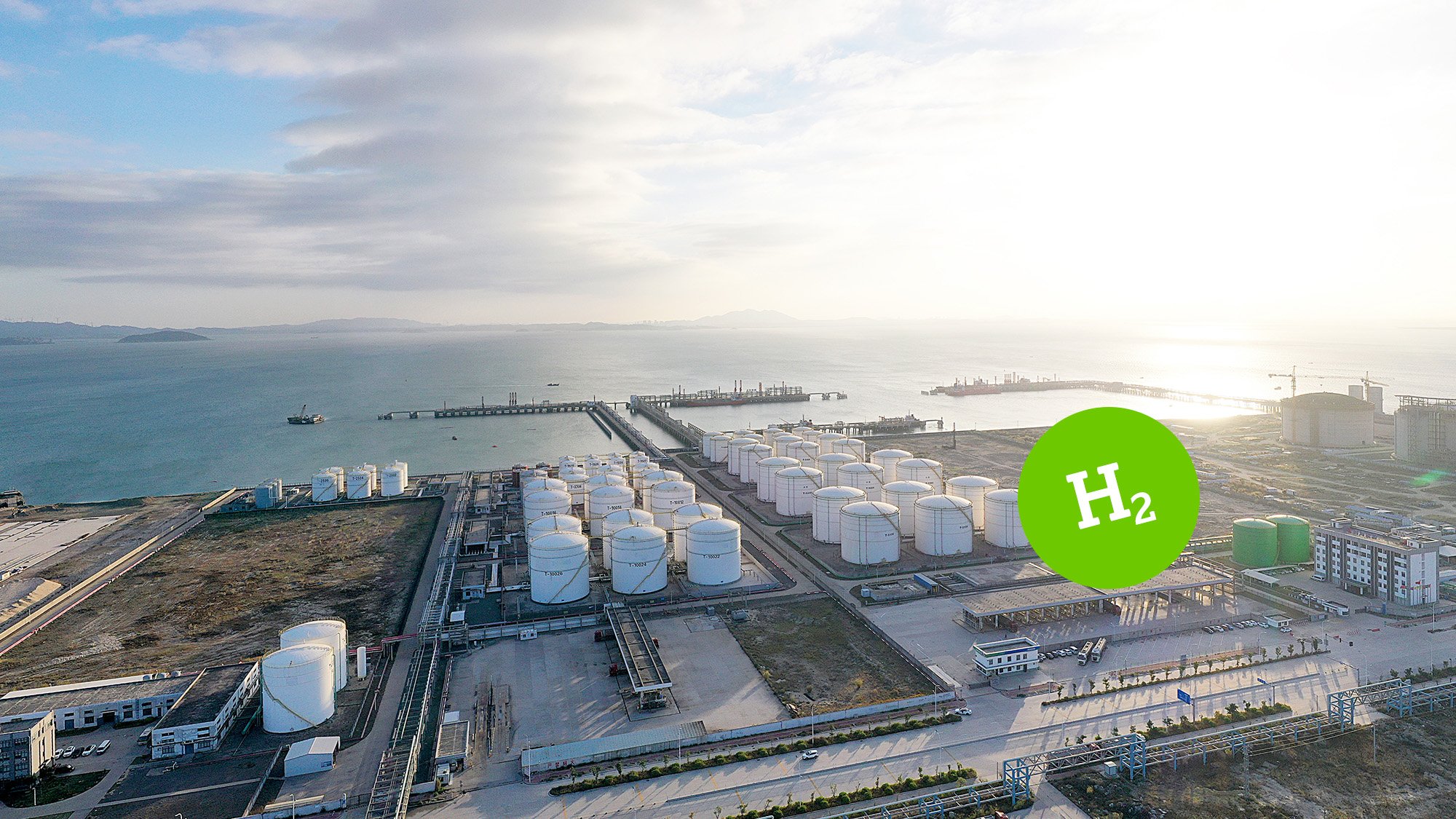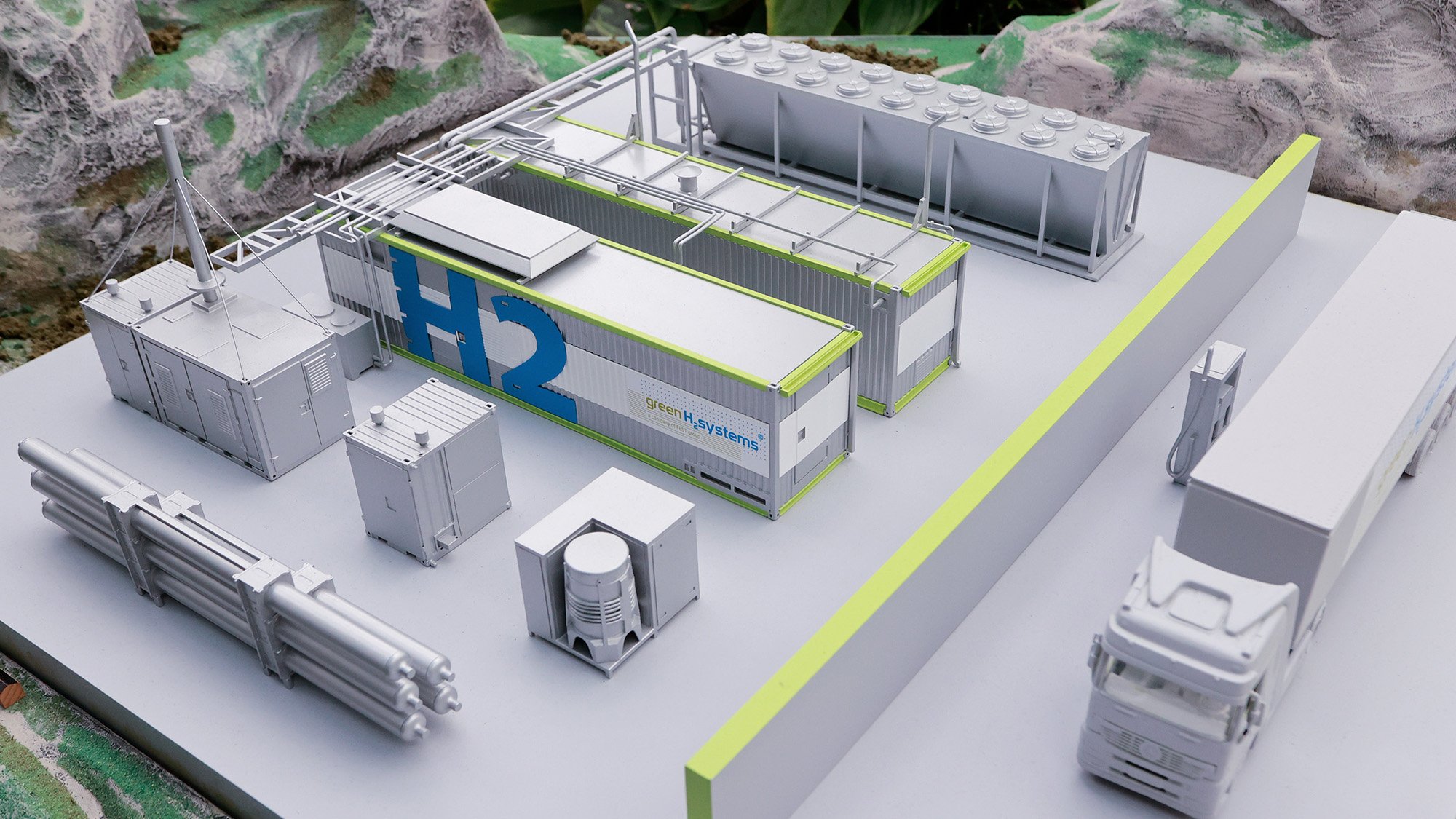


Power-to-X: Your Path to a CO2 Neutral Future
Topics such as decarbonization and the zero-emission economy are now more prevalent in the energy industry than ever. We at WAGO already have a broad spectrum of solutions:
Automation for Modular Hydrogen Generation
In the future, hydrogen will be considered an important energy storage system in the sustainable energy landscape. WAGO and FEST GmbH work together to implement the production of hydrogen through modular systems and the integration of state-of-the-art automation technologies. This will play a central role in the future, sustainable energy system!

From Production and Storage
to the Use of Renewable Energies
Our Products and Solutions for Green Hydrogen
1. Production – Renewable Energies
Green hydrogen will play a key role in achieving the goal of decarbonization and will replace fossil fuels in the long term. Presently, the focus is on the material use of hydrogen, such as for the production of synthetic fuels or in the production of ammonia and methanol.
Green hydrogen is produced from renewable energy sources by electrolysis. Thanks to its storage capacity, generation and consumption can be decoupled from each other. For example, solar energy from PV systems that are surplus in the summer can be stored for winter and low sunshine periods and later accessed as needed. This storage also holds great potential in the telecontrol technology sector to primarily use Germany as a storage location and not have to fall back on the sale of excess energy abroad, as is currently necessary.
For grid-compliant feed-in management of your power plants (PGPs) at the grid connection point (GCP), we recommend our PGP controller with WAGO Power Plant Control. Our robust RTU solutions with IEC 61850, IEC 60870, DNP3 or Modbus® telecontrol protocols are available to optimize your telecontrol technology.
2. Production – Electrolysis
Electrolysis is a proven method for splitting water (H2O) into hydrogen (H2) and oxygen (O2) using electricity. Alkaline electrolysis (AEL), proton exchange membrane electrolysis (PEM) and high-temperature electrolysis (HTE) are the best-known electrolysis methods. Going forward, the green hydrogen produced from renewable energy sources by electrolysis, as a colorless, transparent gas, should cover many of the areas that are still supplied by fossil fuels and thus make a decisive contribution to the decarbonization of our society. In order to convert to a sustainable hydrogen economy over the long term, both smaller, decentralized electrolysis systems and centralized electrolyzers in the megawatt range with particularly high efficiencies are required.
3. Transformation
Hydrogen is widely used as the primary material for the Power-to-X transformation, especially in the chemical industry and refinery technology. Among other things, it is used to produce ammonia and methanol.
Ammonia and Methanol Production
Ammonia is produced by so-called ammonia synthesis. The clear advantage of using ammonia as an energy carrier is that it has a high transport and storage capacity. This makes it possible to use ammonia as a power-to-X in the future, for example, as fuel for motors and for operating power plants. Methanol is an organic chemical produced in large quantities, which can also be used as a basic chemical or an energy carrier. Like ammonia production, hydrogen and CO2 are also required for synthesizing methanol.
Synthetic fuels – so-called eFuels – could be used to operate CO₂-neutral internal combustion engines in the future. A starting material for the production of synthetic fuel is hydrogen. This is obtained by separating hydrogen (H2) from water by electrolysis. To make the hydrogen a liquid fuel, carbon dioxide (CO₂), which originates as a waste product from industry or biogas plants, is then added. The mixture formed in this process assumes the properties of gasoline, kerosene or diesel through specific chemical processes, making it suitable for gasoline and diesel engines or in aircraft propulsion. In addition, the hydrogen bound in the ammonia can be recovered and further used.
Transformation – eFuels, Synthetic Fuels
Whereas conventional fuel is produced from petroleum, natural gas or coal, alternative fuels or propellants are produced from “biogenic” or “synthetic” materials. Biogenic fuels are derived from plants, plant residues or liquid manure. In contrast, CO2-neutral, synthetic fuels are produced by complex chemical processes and, as a rule, without using fossil raw materials. A starting material for the production of synthetic fuel is hydrogen. To make hydrogen a liquid fuel, carbon dioxide (CO₂), which originates as a waste product from industry or biogas plants, is added. These processes give rise to synthetically produced gasoline, kerosene or diesel, which are suitable for conventional internal combustion engines.
4. Transport
Transporting hydrogen is possible without enormous expense via pressure vessels if they are gaseous and via special tanks if they are transported in liquid form. In Germany, the existing natural gas network can even be used for transport, storage and supply. This variant is significantly less expensive than creating completely new systems. Using electrolyzers, excess energy from solar or wind turbines can be stored as hydrogen for longer periods of time. In order to react quickly and individually to current fluctuations, hydrogen can be converted into a current briefly while peak loads occur using fuel cell technology or in conjunction with gas-fired power plants.
To further reduce CO2 emissions, it is technically possible to replace the natural gas energy carrier in industry with hydrogen without extensive modifications or to temporarily mix it with natural gas.
The situation is similar for synthetically produced derivatives, such as fuel, or basic chemical substances, such as ammonia or methanol. Existing infrastructure and procedures can also be used here.
5. End-Use – Steel Industry
The steel industry currently accounts for about 5% of total greenhouse gas emissions. Conventional steel production via the established blast furnace route generates significant amounts of CO2. In order to reduce the degree of emissions, the compounds hydrogen and carbon monoxide relevant for the reduction process can be provided through high-temperature electrolysis. The simplest type of process coupling is the addition of hydrogen to natural gas. The use of green hydrogen can lead to significant savings in CO2 emissions.
6. Final Use – Chemical Industry/Refineries
Hydrogen plays an important role in the chemical industry and refinery technology as a raw material. However, large amounts of hydrogen are required to make CO2 neutrality technically possible for road, marine and air traffic. So-called Power-to-X (PTX) processes are used to cover this need, for example, to convert excess electricity into hydrogen and then convert it into fuel. Green hydrogen and CO2 from the atmosphere, or industrial processes and biomass, can be used to produce synthetic fuels. Basically, it is more efficient not to convert electricity into other forms of energy but to use it directly. However, since renewable energy sources cannot guarantee continuous and constant power generation, the Power-to-X processes, in combination with storage technologies, can become an important component of energy transition in the future.
7. End-Use – Mobility Sector
With Power-to-X technologies and processes, renewable energy can be stored long term and used in an environmentally friendly way, regardless of the location of the power producers. “Green” hydrogen and its derivatives become completely emission-free energy sources: primarily for synthetic kerosene in aviation, ammonia or methanol.
Hydrogen is thus becoming a sustainable alternative for ship propulsion, as fuel cells for heavy-duty and rail transport, and for battery-electric vehicles used in personal transportation – especially where battery-electric systems have reached their limits.
